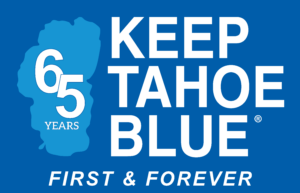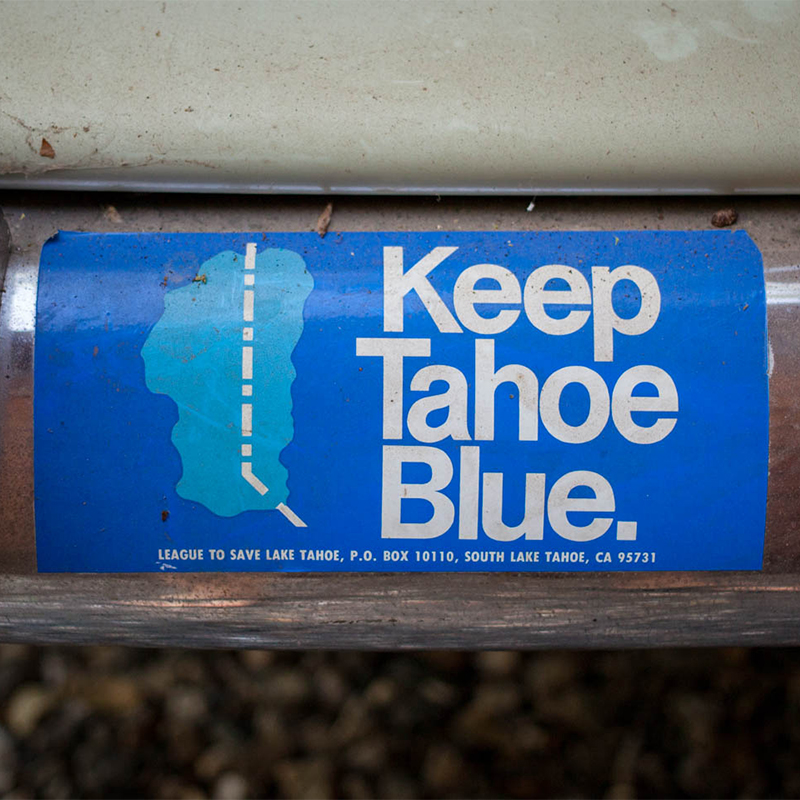Behind the popular sticker, there are 65 years of history
Read the article in the Winter 2022 edition of Tahoe Magazine, page 26.
While you’re pulling on your boots in the parking lot of any Tahoe ski resort or trailhead, look around for a two-tone blue sticker with that familiar, three-word call to action: “Keep Tahoe Blue.” It might be on a water bottle, windshield or your neighbor’s cooler, but chances are it won’t be far away.
The simple mantra on those stickers has become synonymous with the region, and recognizable to the millions who visit the Lake Tahoe Basin each year. But far fewer people know the six decade-history of Keep Tahoe Blue and the movement it represents, which has helped preserve the Tahoe you know and love. Here’s a glimpse of the story behind the sticker.
Flashback to the 1950s
At midcentury, Lake Tahoe was a rapidly growing alpine getaway with newly built lakefront hotels and casinos. In 1956, it was announced that the winter Olympic games were coming to Tahoe in four short years, ushering in a wave of global attention and development. In 1957, the Tahoe Keys development broke ground on the lake’s south shore. The project replaced more than 700 acres of marsh ecosystem with a neighborhood of 1,000+ homes connected by man-made canals.
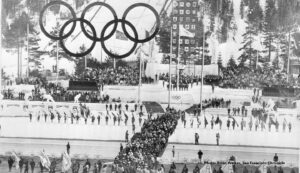
The opening ceremony of the 1960 Winter Olympics at Tahoe. Photo: Brian Walker, San Francisco Chronicle
While Tahoe was growing, it was difficult and often dangerous for travel. Winter storms frequently closed roads, especially at Emerald Bay, frustrating businesses with lost profits. A solution was proposed: build a bridge 2/3 of a mile long across the mouth of the bay, bypassing the slide-prone slopes, but also defacing Tahoe’s most iconic landmark. The concept was later expanded to include a high speed freeway ringing the lake, dense pockets of development and a year-round population topping 500,000 (compared to 60,000 in the basin today.)
During this era, building took a heavy toll on the environment because projects were placed close to the lake – frequently on ecologically sensitive lands like meadows – to increase their appeal. Erosion, polluted runoff and sewage tainted the lake, steadily reducing its famous water clarity.
A small group of concerned citizens took note of the frightening trends. They understood the consequences for the Lake’s famous blue water, which had inspired writers from John Muir to Mark Twain. So, they decided to do something about it.
Over dinner in 1957, Bill Evers and Jim McClatchy founded the Tahoe Improvement and Conservation Association. Within a few years, the fledgling environmental group would score major victories against out-of-control development and pollution. Along the way, the nonprofit’s leaders changed the name to the League to Save Lake Tahoe and coined the three-word mantra, Keep Tahoe Blue, that might be on the bumper of your car right now.
Preventing “a city with a big hole in the middle of it”
When the League was founded, the first Earth Day was more than a dozen years away and environmental concerns took a back seat to profitability. The League’s early members knew they needed a persuasive argument to rein in damaging development. They found an ally in science.
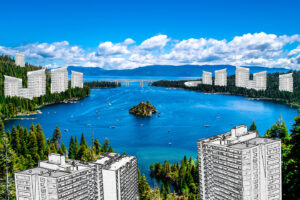
A glimpse of what Emerald Bay may have looked like without the League’s earliest victory to stop a massive development plan.
Dr. Charles Goldman joined the faculty at the University of California Davis in 1958, fresh from receiving a doctorate in limnology, or lake science. Goldman began pioneering studies on Lake Tahoe, including measuring its clarity, or how deeply one can see into the lake from the surface. He quickly recognized that development pressures made the clear lake highly vulnerable to runaway algae growth or “greening,” which would ruin its rare transparency.
The League took Goldman’s research and amplified it. Through a series of often contentious public meetings, the researcher and environmental advocates shared the scientific conclusions with the community: if uncontrolled development continued, Lake Tahoe would lose its clarity. The “Keep Tahoe Blue” slogan was born from this experience to concisely share what was at stake. And it worked. Clear communication and a “science to solutions” approach has been the guiding light for the League’s work for more than six decades.
The scientific-nonprofit partnership, paired with relentless lobbying in Carson City and Sacramento, proved powerful. It finally put an end to the plan for a bridge over Emerald Bay and the San Francisco-sized development that was tied to it. Those efforts kept Tahoe from becoming “a city with a big hole in the middle of it,” as a planner from the 1960s once put it.
The important victory didn’t end attempts at inappropriate development. In the decades that followed, the League took developers and public agencies to court to ensure Tahoe was protected from the impacts of bad building. The legal decisions that followed helped ban new casinos and subdivisions, and confine development within urban growth boundaries to spare natural habitats.
Winning national support
Appealing directly to decision-makers has been central to the League’s work from the beginning. Over the decades, their lobbying efforts helped create a strong set of environmental protection policies, establish programs that preserve and restore the lake, and secure sustainable funding.
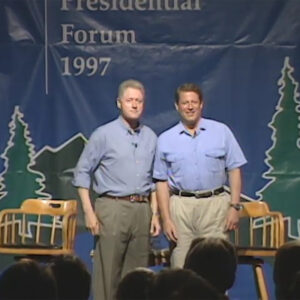
President Clinton and Vice President Al Gore speak during the 2007 Tahoe Presidential Forum. Photo courtesy of the William J. Clinton Presidential Library.
By the early 1990s, the League had banded together with a diverse coalition of homeowners groups, and ski and casino industry leaders to find funding for Tahoe’s environmental priorities. At that point, Tahoe didn’t receive any federal support, even though a congressionally-approved regulator with bi-state jurisdiction, the Tahoe Regional Planning Agency, had been in place since 1969. The coalition of members believed Tahoe was a national treasure deserving more than it was getting. So they set out to make their case.
The coalition started by building congressional support in Nevada and California. They found willing allies in Senators Harry Reid and Dianne Feinstein. The two managed to coax President Clinton and Vice President Gore to visit Lake Tahoe and see firsthand why it deserved federal support. The result was the 1997 Lake Tahoe Presidential Forum, which brought national and international attention to the lake, its beauty and its challenges. (Tahoe’s representatives still gather every summer for the annual Tahoe Summit.) The ‘97 event built momentum for legislation that has since directed almost $2 billion to coordinated efforts to improve Tahoe’s delicate environment. Together, the funding allocated through the Lake Tahoe Restoration Acts and the framework provided by the Lake Tahoe Environmental Improvement Program have helped tackle aquatic invasive species, improve transportation, combat pollution, restore damaged ecosystems, and protect the lake’s world-famous water quality.
A shift toward shared stewardship
Fast-forward to the 2010s. Lake Tahoe had grown, especially as a tourism destination. It’s estimated (conservatively) that Tahoe receives 15 million visitors per year. All those pleasure seekers enjoying the outdoors leave impacts. The most pressing among those threats are litter, aquatic invasive species, and traffic. The effects of climate change exacerbate the severity of each threat.
In the face of this, it was clear that nonprofits, agencies and governments alone could not save the lake. They would need help from residents and visitors. Over the past decade, the League has rolled out a wide range of opportunities for anyone to “be part of the solution.” That includes litter cleanups, hands-on ecosystem restoration projects, and a suite of programs that turn volunteers into citizen scientists.
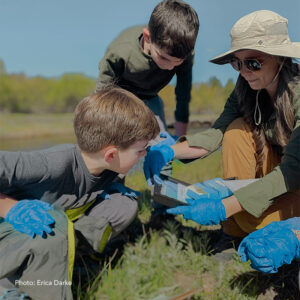
Volunteer citizen scientists test water samples for the League’s 2022 Snapshot Day. Photo: Eric Darke
Each of the League’s citizen science programs are designed to address an environmental challenge. Pipe Keepers fight polluted runoff from urban areas. Eyes on the Lake volunteers sound the alarm on new populations of aquatic invasive species. Tahoe Blue Crews gather litter data as they clean up adopted sites. And at Tahoe Forest Stewardship Days, participants heal damaged meadows, streams and forests through hands-on work.
For those with busy schedules, quick and simple actions – like picking up litter, or choosing a reusable bottle instead of single-use plastics – makes you a #TahoeBlueGooder. Whether you have five minutes or five hours, you can help Keep Tahoe Blue.
The League is not alone in this push. Businesses, destination management organizations, nonprofits, public agencies and research institutions are all spreading the stewardship ethic. That’s what Tahoe needs to stay blue – hundreds of thousands of helping hands taking small, Lake-friendly actions.
Fixing traffic and preventing pollution
For decades, traffic has crushed Tahoe’s roads into fine dust and debris that flow into the lake, damaging its water clarity. Long lines of cars are also just a headache. Improving transportation is imperative for both the environment and economy.
In recent years, the League has delivered alternative, Lake-friendly travel options to the basin to coax people out of their cars. In 2017, the League attracted dockless bikeshare, and then scooters, to the south shore. The two-wheeled options found success from the start. At the outset, Tahoe often outpaced ridership in much larger cities like Miami and Los Angeles, showing that people were willing to leave their cars behind and enjoy getting around at Tahoe as part of the experience. To date, users have taken nearly 940,000 trips for a cumulative 1.1 million miles – miles that would have likely been traveled by car. E-bikes offered for rent by local shops have also proved a popular option. Both scooter and bike riders take advantage of safe, world class bike paths that weave through meadows and forests.
Next, the League debuted Tahoe’s first microtransit service in 2018 as a proof-of-concept pilot project. Microtransit is like Uber or Lyft, offering on-demand rides via smartphone app. But importantly, rides are free and shared. The model gathered steam quickly when the Mountaineer service began offering rides between Alpine Meadows and Olympic Valley in the winter of 2018. Today, the concept has grown in popularity and reach. Free rides are available on the north and west shores from TART Connect, and on the south shore from Lake Link, thanks to the work of businesses, governments and associations. The League was an advocate and financial supporter of TART Connect, and their advocacy led directly to the creation and funding of Lake Link.
Continuing to work in coordination with partners, the next steps are to expand, connect and electrify these services. When there is a functioning network of alternative options to travel around the Basin, traffic – along with the pollution and stress it creates – can become a thing of the past. Plus, Tahoe is better enjoyed by bike, on foot or from the passenger seat anyhow.
A job that’s never done
For 65 years, the League has strived to protect Lake Tahoe. In that time, the threats have evolved, so the solutions had to as well. Yet the goal has remained clear: to Keep Tahoe Blue. The work continues today and will into the future.
That familiar, blue sticker on your water bottle – small and simple as it seems – says a lot in just three words. Maybe it will inspire you to do something to protect the lake too. Visit keeptahoeblue.org and @keeptahoeblue to see all the ways you can do your small part.
